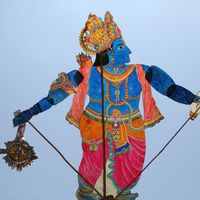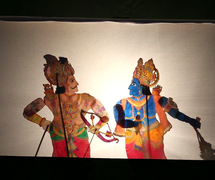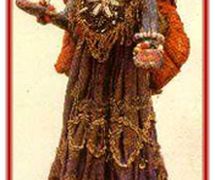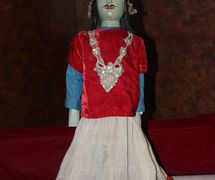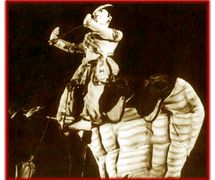God belonging to the Hindu pantheon, avatar of Vishnu, an important character of puppet theatre as well as of shadow theatre in India and in South East Asia. Perhaps the most beloved god among Hindus, Krishna has thousands of representations. First a child, with plump cheeks and always smiling, butter-thief, prankster, who adores his human mother. Krishna grows up to be a handsome young man who watches over the herd, and seduces ninety-nine thousand, nine hundred and ninety-nine gopis (female cow herders), while playing his flute. Even as he satisfies them all, at the same time, he has a personal favourite, Radha. The couple Radha-Krishna symbolizes deep love, though Krishna remains, in everyone’s view, the eternal lover.
In the Mahabharata, he plays an important role. Sometimes Krishna is the dispenser of justice, but sometimes he brews trouble, inciting people towards vengeful acts, while at other times he appears to act traitorously in the Great Bharata War. However, all his actions are aimed for the greater good in what is unquestionably a just war.
In many puppet theatre traditions in India, Krishna is depicted as a king, a war chieftain, wearing a golden crown with double or triple cupolas, carrying a bow. Even though he does not belong to the lineage of Shiva, his skin is shown to be blue or green or even very dark. A slight smile plays around his lips. In the Kerala glove puppet theatre tradition, pavakathakali, Krishna is shown with a slender golden halo around his head.
Also in pavakathakali Krishna wears a yellow crinoline-like garment, whereas in the yakshagana gombeyata of Karnataka, the puppet character’s legs are clothed in yellow trousers or draped leggings in the Parthian style, probably dating back to the times of the Mughal (Mogul) Empire when this style of performance was born.
(See India.)









